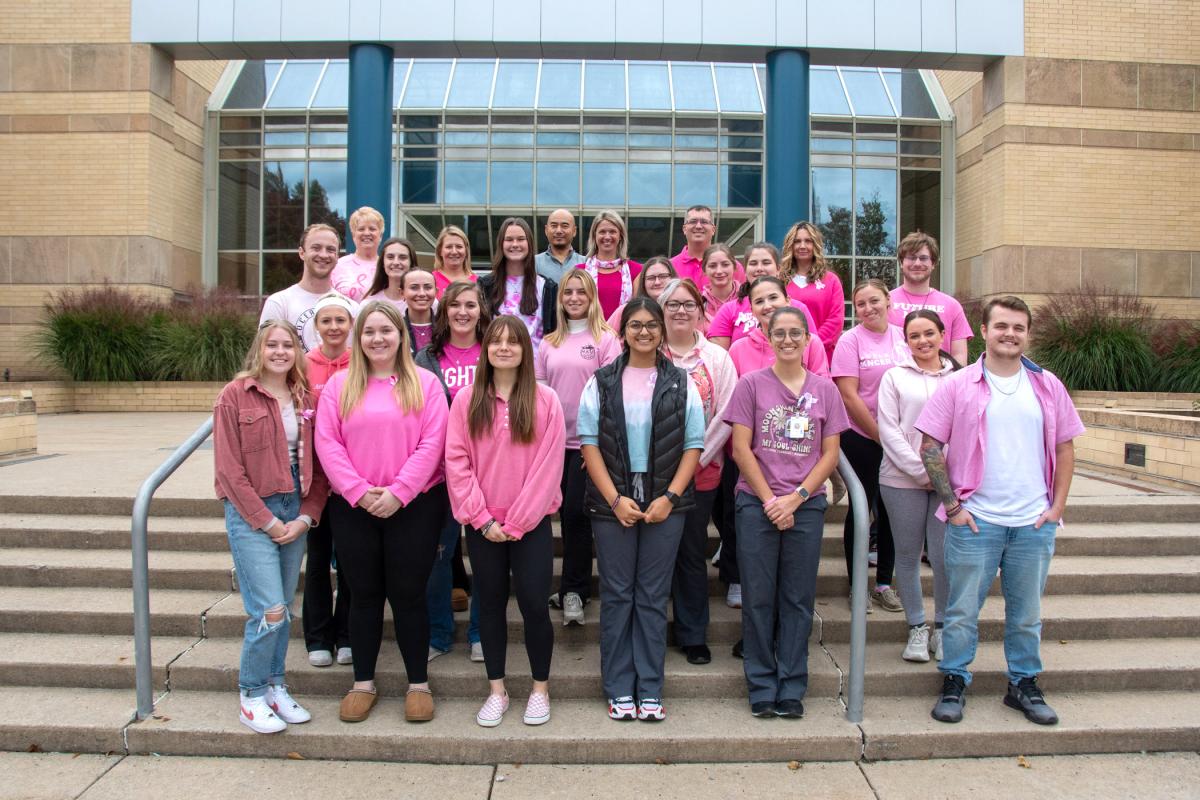Radiography students hold Pink Out for breast cancer awareness
Published 10.23.2023
Pennsylvania College of Technology’s radiography program celebrated Breast Cancer Awareness Month on Oct. 18 with a show of pink – the color designated for bringing attention to breast cancer and early detection of the disease.
Earning a degree in radiography is the first step to becoming a mammographer (a mammogram is an X-ray that allows a radiologist to examine the breast tissue for any suspicious areas) – one of several advanced modalities in the medical imaging field. And for many in the college’s radiography program, the importance of the work holds special meaning.
Among them is Lisa M. Dostick, clinical supervisor of radiography, who started her collegiate career as a nursing student in 1998.

“After one semester, I realized quickly that it was not the educational path I wanted to pursue,” she said. “After speaking to my adviser about the different health care options, I decided on radiography simply because I loved photography. As radiographers, we are the eyes of medicine, oftentimes seeing illnesses and injuries firsthand.”
As part of her radiography education, she experienced different modalities within medical imaging, including mammography, MRI, CT, nuclear medicine and ultrasound.
“It was during my mammography experience that my own mother came in for a palpable breast mass,” Dostick recalled. “Imagine the fear and anxiety that flooded our minds, as her own mother, my grandmother, had bilateral breast cancer. It was this memorable experience and the kindness and personalized patient care my mother received that inspired me to pursue mammography as an additional credential to radiography.”
Dostick continued to work in breast imaging for 20 years before becoming a clinical instructor at Penn College.
“I enjoyed educating patients on the significance of breast cancer and being part of the cause for a cure,” Dostick said. “Just this past year, I had my own scare when I had an abnormal report following my annual screening mammogram. With my strong family history of breast cancer, the breast specialists immediately took action with additional imaging to include an MRI and eventually an ultrasound-guided breast biopsy. Breast health includes annual breast cancer screening and may include various imaging modalities to access the breast.”
Dostick shared these recommendations from the American Cancer Society:
- Women between 40 and 44 have the option to start screening with a mammogram every year.
- Women 45 to 54 should get mammograms every year.
- Women 55 and older can switch to a mammogram every other year, or they can choose to continue yearly mammograms. Screening should continue if a woman is in good health and is expected to live at least 10 more years.
Mammograms can often show a lump before it is palpable, Dostick explained. They can also show micro-calcifications, cysts and many other breast abnormalities. Further tests may include MRI and ultrasound.
“The importance of mammography screening is crucial, as 1 in 8 women in the United States will be diagnosed with breast cancer in their lifetime,” Dostick said. “In 2023, an estimated 297,790 women and 2,800 men will be diagnosed with invasive breast cancer, and an estimated 43,700 women will die from breast cancer in the United States.”
Mammography is one of the few advanced medical imaging modalities that allow students still in a radiography program to begin working on their competencies in the specialty, explained Christine L. Eckenrod, director of radiography at Penn College. Students learn about all of the advanced modalities, including mammography, in the Advanced Modalities course in the spring of their second year.
“There is currently a shortage of all medical imaging professionals, including mammographers,” Eckenrod said.
“Screening mammograms, performed by qualified registered mammography technologists, are part of the movement to fight breast cancer,” Dostick said. “The journey to become a registered mammography technologist begins with radiography – the very program offered here at Penn College. I consider it an honor to teach here at PCT in a health care field that is such a big part of the fight against breast cancer.”
To learn more about the radiography program at Penn College, call 570-327-4519.
For information about the college, a national leader in applied technology education, email the Admissions Office or call toll-free at 800-367-9222.